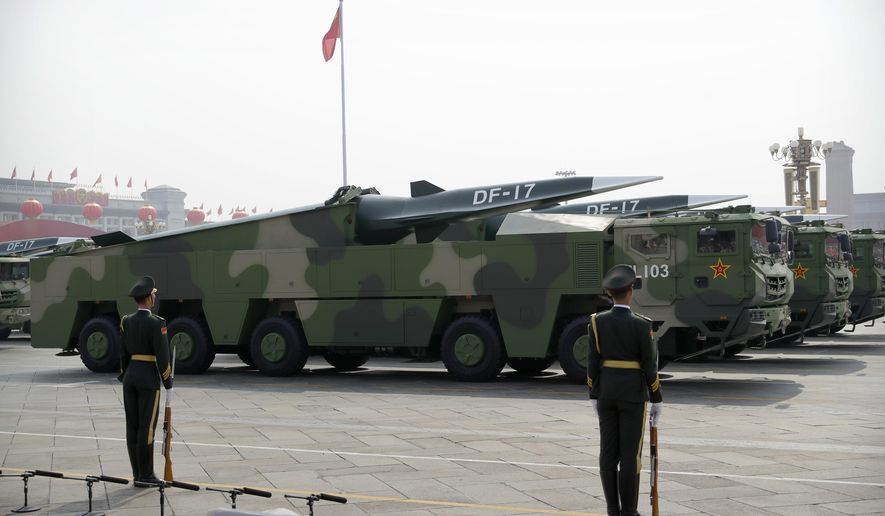China’s test of an orbiting hypersonic missile last year demonstrated Beijing’s longest range land attack weapon and is part of a growing arsenal of space warfare capabilities, according to a Defense Intelligence Agency report on space threats released Tuesday.
The hypersonic missile test in July was one element of the arsenal of space weaponry built and deployed by China and Russia that is aimed at attacking U.S. satellites used by the military for communications and precision-guided missiles, the DIA report states. Joint Chiefs of Staff head Gen. Mark A. Milley last fall memorably called the Chinese hypersonic test “very close to a Sputnik moment” for U.S. military planners.
“The loss of space-based communication and navigation services could have a devastating impact on warfighters during a conflict — that’s one of the most serious scenarios anticipated,” DIA Director Lt. Gen. Scott Berrier said in releasing the report.
“A secure, stable and accessible space domain is crucial as China and Russia’s space-based capabilities and electronic-warfare activities continue to grow,” Gen. Berrier added.
Space-based electronic systems are used in homes, transportation networks, the electrical grid, banking systems and for conducting military operations around the world, the report said.
“Adversaries have observed more than 30 years of U.S. military operations supported by space systems and are now seeking ways to expand their own capabilities and deny the U.S. a space-enabled advantage,” the report said.
The July 27, 2021, launch of a Chinese ICBM tipped with a hypersonic glide vehicle — an ultrahigh-speed, maneuvering missile — is known as a fractional orbital launch. The glide vehicle traveled around 24,800 miles in space before reentering the atmosphere and successfully striking a ground target.
The flight test lasted more than 100 minutes, making it “the greatest distance flown and longest flight time of any Chinese land attack weapons system to date,” the report said.
The Chinese have been developing space-based weapons since 2006 that will be “used to attack ground, sea, or air targets from space,” the report said. The development includes methods to safely reenter the atmosphere, separating payloads, building delivery vehicles and transferring orbits as part of the targeting process.
China’s space warfare arsenal also includes sensors capable of targeting satellites, ground-launched anti-satellite missiles, orbiting killer robot satellites that can grab or crush satellites, and laser, electronic and cyberspace warfare tools.
The report, “Challenges to Security in Space,” states that the combined military and civilian space fleets of China and Russia grew by 70% between 2019 and 2021. The 80-page report highlights the growth in space sensors and satellites used to prepare space for military operation and outlines the military units in charge of space warfare.
Both China and Russia also are seeking to explore the moon and Mars and their tests, including a recent Russian destruction of a satellite with a missile, produce dangerous floating debris that threatens satellites and crewed spacecraft for decades and even centuries.
Russia tested its Nudol anti-missile system against a satellite in November, producing over 1,500 large debris pieces and tens of thousands of pieces of “lethal but non-trackable debris,” the report said.
Russia’s space weaponry also includes several ground-based lasers guns that can blind or destroy orbiting satellites, including a laser weapon called Peresvet that Russian President Vladimir Putin called “a new type of strategic weapon.” The ground-mobile Peresvet laser has been deployed with five strategic missile divisions and would be used to blind enemy optical intelligence satellites and mask the movement of mobile strategic missiles.
Moscow also is building an air-launched anti-satellite missile called Burevestnik fired from a MiG-31 jet.
Orbiting Russian anti-satellite systems including robot satellites that can maneuver close to satellites and launch explosives or use electronics to destroy satellites. One of these satellites launched in November 2019 tracked a U.S. national security satellite, “approaching close enough to create potentially dangerous operating conditions,” the report said.
Kevin Ryder, DIA’s senior analyst for space and counterspace, said China’s hypersonic test last year was the first time the weapon was observed. He noted it is “a little early” for intelligence analysts to determine if the weapon will be used for nuclear strikes, conventional attacks or both.
China has invested more in its space capabilities than Russia, Mr. Ryder noted.
Asked which Chinese or Russian space warfare capability is most alarming, John F. Huth, DIA’s defense intelligence officer for space and counterspace, said all the threats are a concern.
“It’s not just a capability,” he said. “It’s the fact that they both have a space force and their intent is to make space part of that combined arms efforts.”
Mr. Ryder agreed. “From my perspective, all the capabilities are equal in nature and it depends on how, when and where they use them,” he said.
Other sections of the report note that Iran and North Korea appear to be developing space capabilities that can be used in future wars.
“Iran recognizes the strategic value of space and counterspace capabilities and will attempt to deny an adversary use of space during a conflict,” the report said.
“North Korea’s ballistic missiles and [space launch vehicles], such as the Unha-3 SLV, in theory could be used to target satellites in a conflict.”
Nuclear weapons also could be detonated in space to create an electronics-damaging electromagnetic pulse.
In contrast to the growing space weapons threat from overseas adversaries, the newly created U.S. Space Force has a single declared weapon: an electronic jammer and boasts no anti-satellite missiles.
However, a modified Navy SM-3 anti-missile interceptor was used to successfully shoot down a falling National Reconnaissance Office satellite in February 2008, demonstrating some anti-satellite missile capability.
Space Force counterspace weapons development remain classified and are said to be hampered by opposition from arms control advocates who oppose accelerating the arms race in space. Despite advanced space warfare capabilities, both China and Russia are promoting arms control initiatives aimed at limiting U.S. space warfare capabilities, the report said.
• Bill Gertz can be reached at bgertz@washingtontimes.com.




Please read our comment policy before commenting.